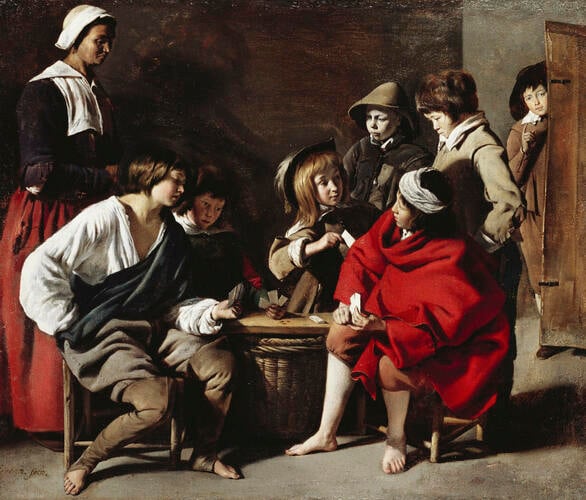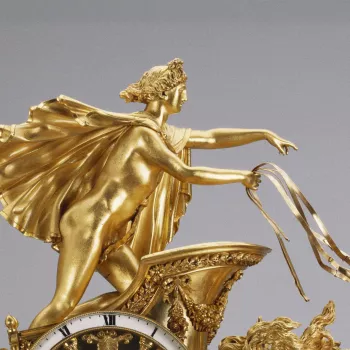The Young Card-players c.1630-40
Oil on canvas | 55.0 x 64.2 cm (support, canvas/panel/stretcher external) | RCIN 405944
-
When purchased at auction in 1803 by the future George IV, this picture was described as an 'exquisite jewel' and attributed to Caravaggio. Indeed, recent restoration has revealed that the composition had been altered dramatically to enhance its Caravaggesque elements. Such changes, which were probably made during the eighteenth century, included the removal of the bandage around the head of the seated boy in the right foreground, and the omission of the standing woman and the signature. The restored composition is now closer to other known versions of the same piece in the Louvre and Worcester (Massachusetts), but it is still unclear which of the three Le Nain brothers was the artist.
To the modern eye, this painting has a compositional directness and a strong tonal range that are immediately appealing. The central group are playing Primero or Primiera, a forerunner of poker. The theatrical lighting, falling sharply from the left, defines the objects and clothes, and the enigmatic gesture of the boy entering the room on the right adds an air of mystery.
The three Le Nain brothers - Antoine, Louis and Mathieu - were born in Laon and by 1629 had settled permanently in Paris, where they became founding members of the Académie des Beaux-Arts in 1648. Despite gaining respect in their own day for paintings of religious and mythological subjects, as well as portraits, they are best known for their dignified pictures of peasant life. Although the popularity of the Le Nain brothers waned during the eighteenth century, their distinctive style has appealed to modern taste, possibly owing to the interest shown in similar subjects by nineteenth-century French artists such as Manet.
Catalogue entry from Royal Treasures, A Golden Jubilee Celebration, London 2002Provenance
Acquired by George IV, when Prince of Wales, at the Walsh Porter Sale, Christie's, London, 22 March 1803 (48), as a Caravaggio, said to have come from the Aldobrandini Palace, Rome; recorded in 1816 in the Middle Attic Room, Carlton House, as Le Nain. Listed as Le Nain in 1841 in the Picture Gallery, Buckingham Palace, with the observation that 'it is singular that no account can be found of the life of this eminent artist, whose works for truth and character may rank with the best productions of Murillo or Caravaggio'.
-
Creator(s)
Previously attributed to (artist)Acquirer(s)
-
Medium and techniques
Oil on canvas
Measurements
55.0 x 64.2 cm (support, canvas/panel/stretcher external)
77.1 x 79.8 x 6.6 cm (frame, external)
Category
Object type(s)









